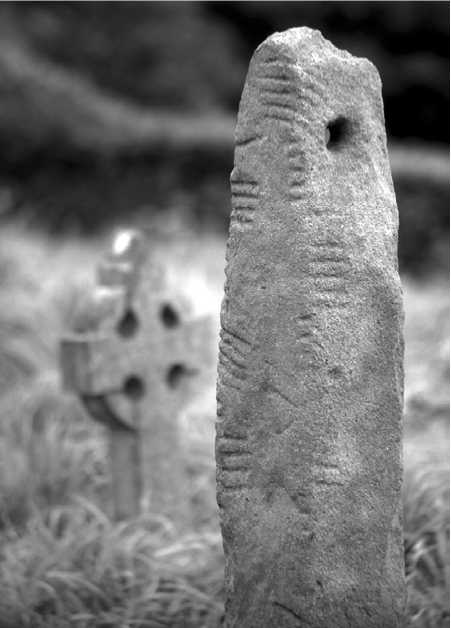The oldest surviving Irish texts are a series of about 300 Primitive Irish inscriptions carved on stone pillars, apparently during the 5th and 6th centuries. These short and formulaic texts have no literary content, but consist largely of male personal names. There are minor variants on this basic theme, but beyond names the vocabulary is more or less limited to a few terms for kinship and other social roles. As the only direct evidence for the state of the language in this early period, the inscriptions are of considerable importance to the linguist.
‘Primitive Irish’ is a term used to describe a state of the language in which the original Old celtic final syllables of polysyllables were preserved. irish names and terms begin to be written without their Primitive Irish final syllables in some ogam inscriptions that probably date to the 6th century ad, but more inscriptions are written with the Old celtic final syllables.
The inscriptions exhibit several remarkable features, but by far the most striking is the script in which they are written—not the Roman capitals of contemporary British and Continental inscriptions, but a uniquely Irish script known as ogam in Old Irish (Modern Irish ogham). The origins of this script are obscure: Although clearly inspired by the Roman alphabet, ogam exhibits considerable visual and conceptual independence from it. Written from left to right along a continuous line, ogam letters consist of bundles of between one and five short parallel strokes adjoining the central stem (druim). Epigraphic ogams are usually inscribed vertically and read from bottom to top. The twenty original letters are arranged in a fixed order in four groups (aicmi): Over time additional letters (forfeda) were added to this inventory in response to evolving Irish phonology.

Standing stone with ogam inscription, Kilmakedar, Dingle Peninsula, County Kerry, Ireland (Cill Mhaoilcheadair, Corca Dhuibhne, Contae Chiarrai, Eire). (Gary Elsner/StockphotoPro)
Three main phases of ogam usage can be distinguished in the 1,500 years since the invention of the script. Its heyday came during the two centuries before 600 when ogam is found in monumental use in all the Irish-speaking regions of the British Isles.
The overwhelming majority of these ‘orthodox’ inscriptions are found in Munster (Mumu), with particular concentrations in Co. Kerry (Contae Chiarrai) and Co. Cork (Contae Chorcai). A small number are observed in Scotland (Alba) and the Isle of Man (Ellan Vannin), and rather more numerous groups in Wales, Devon (Welsh Dyfnaint), and Cornwall (Kernow). No ogam-inscribed stones have been discovered on the European mainland. Most of the ogam inscriptions in western Britain are accompanied by Latin versions of the same text. These bilingual dual-script monuments played an important role in refining modern knowledge of the correct transliteration of ogam.
Social change in the 7th century brought the tradition of erecting ‘individual inscribed memorials’ to an end, and with it the main body of evidence for early ogam dries up. A handful of chance survivals, including graffiti, informal inscriptions on domestic objects, and manuscript marginalia, suggest that ogam did continue in limited use beyond the 7th century. Law texts refer to ogam-inscribed stones as evidence of title to land, and descriptions of heroic burial in the sagas mention the carving of the name of the deceased on a pillar above the grave. These matter-of-fact references tally well with the physical evidence. Less secure are the saga descriptions of the non-monumental use of ogam. Tain Bo Cuailnge (‘The Cattle Raid of Cooley’) cites several instances of ogam carved on a withe and hung on a pillar-stone as a challenge or warning, but there is no corroborating evidence for saga references to the use of ogam for divination or cryptography. There is nothing intrinsically cryptic or occult about ogam, and it must be emphasized that its use in early Ireland was first and foremost as a practical day-to-day script.
The prestige of ogam had diminished by the 7th century, as reflected in its restriction thereafter to private secular and informal, even playful, ecclesiastic contexts. The relative standing of the ogam and Roman alphabets in this ‘postclassical’ phase echoes in certain respects the relationship between runes and Roman letters in Anglo-Saxon England. There is a definite change in the appearance of ogam at this point: Gone is the three-dimensionality of the orthodox pillars, with letters on adjacent faces of the stone and the arris for a stem; in its place arises a drawn-in stem-line, written across the flat surface as if across a manuscript page. A break with the old spelling system occurred as well. The ogam characters ceased to represent the sounds of Irish directly and became instead a cipher for Old Irish manuscript spelling. As a mere transliteration of Roman letters, ogam could now, in theory, be applied to any language, and in fact there are examples of Latin written in ogam characters.
An important exception to the more marginal status of later ogam is the remarkable effloresence of the script in post-7th-century Scotland, where its prestige was such that it ousted the Roman alphabet as the preferred monumental script. The adaptation of the script to represent the sounds of Pictish is the only instance of the practical use of ogam for a language other than Irish. A scatter of late ogam inscriptions from Shetland (Sealtainn), the Isle of Man, and Ireland (including Viking Dublin [Baile Atha Cliath] and an ogam-runic bilingual monument from Killaloe, Co. Clare [Cill Dalua, Contae an Chlair]), suggest that a revival of interest in the script occurred in Celto-Norse circles in the 10th and 11th centuries. These constitute the latest examples of ogam in practical use. Thereafter, there are texts about ogam, but no more texts in ogam.
It is a popular misconception that all ogam letters were named for trees. Ogam remained part of the training of a file ‘poet’ until the 17th century (see bardic order), with the letter names surviving thereafter as the names of ordinary Irish letters. The elaborate system of prophetic meanings attached to ogam characters is a recent creation unrelated to genuine ogam tradition or any magical use of ogam letters that may have occurred in the past.
Katherine Forsyth




 World History
World History









